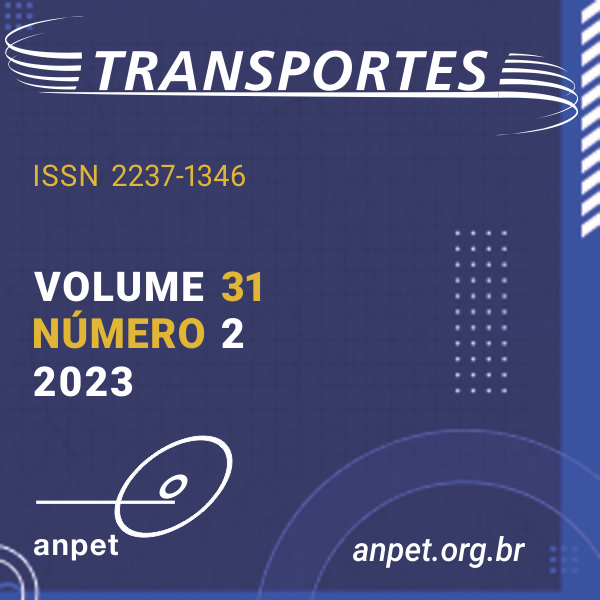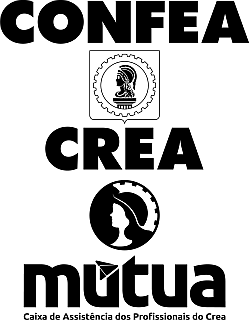Propriedades mecânicas e hidráulicas de geotêxteis não tecidos impregnados com emulsão asfáltica após simulações de danos
DOI:
https://doi.org/10.58922/transportes.v31i2.2809Palavras-chave:
Geossintéticos, Estrada reforçada, Impregnação, Durabilidade, Fator de redução, Emulsão asfálticaResumo
Este estudo avalia as propriedades mecânicas e hidráulicas de geotêxteis não tecidos impregnados com emulsão asfáltica após a simulação de danos de instalação em condições de laboratório. Além do método de dano recomendado pela ISO 10722 (ISO, 2007), este estudo considerou duas aplicações de carga estática. Dois tipos de geotêxteis não tecidos (fibras de poliéster e polipropileno) foram investigados em diferentes condições: i) impregnação com emulsão asfáltica; ii) condição de carregamento/dano; e iii) material de base. As propriedades avaliadas antes e após a simulação dos danos foram resistência à tração, alongamento na ruptura, rigidez secante a 2% de deformação e permissividade. Os resultados revelaram que a impregnação aumentou a resistência à tração e a rigidez à tração secante dos geotêxteis, mas diminuiu o alongamento na ruptura e a permissividade. De modo geral, os geotêxteis apresentaram boa resistência aos danos de instalação investigados, mas, após a impregnação, o geotêxtil de polipropileno mostrou-se mais sensível aos danos. A composição da emulsão asfáltica demonstrou ser importante para as propriedades e a resposta dos geotêxteis aos danos. Conclui-se que a impregnação melhorou as propriedades mecânicas dos geotêxteis, mas seu efeito sobre a permissividade e a resistência a tração dos geotêxteis aos danos da instalação devem ser cuidadosamente quantificados e analisados para fins de projeto.
Downloads
Referências
Allen, T.M. and R.J. Bathurst (1994) Characterization of geostynthetic load-strain behavior after installation damage. Geosynthetics International, v. 1, n. 2, p. 181-99. DOI: 10.1680/gein.1.0008. DOI: https://doi.org/10.1680/gein.1.0008
ASTM (2005) ASTM D 6140: Standard Test Method to Determine Asphalt Retention of Paving Fabrics Used in Asphalt Paving for Full-Width Applications.” West Conshohocken, PA: ASTM International.
ASTM (2011) ASTM D 5035: Standard Test Method for Breaking Force and Elongation of Textile Fabrics (Strip Method). West Conshohocken, PA: ASTM International.
ASTM (2012) ASTM D 5199: Standard Test Method for Measuring the Nominal Thickness of Geosynthetics. West Conshohocken, PA: ASTM International.
ASTM (2013) ASTM D5/D5M - Standard Test Method for Penetrarion of Betuminous Materials. West Conshohocken, PA: ASTM International.
ASTM (2016) ASTM D 6934: Standard Test Method for Residue by Evaporation of Emulsified Asphalt. West Conshohocken, PA: ASTM International.
ASTM (2017a) ASTM D 4491: Standard Test Methods for Water Permeability of Geotextiles by Permittivity. West Conshohocken, PA: ASTM International.
ASTM (2017b) ASTM D 7496: Standard Test Method for Viscosity of Emulsified Asphalt by Saybolt Furol Viscometer. West Conshohocken, PA: ASTM International.
ASTM (2018) ASTM D 5261: Standard Test Method for Measuring Mass Per Unit of Geosynthetic Clay Liners. West Conshohocken, PA: ASTM International.
Carlos, D.M.; J.R. Carneiro and M.L. Lopes (2019) Effect of different aggregates on the mechanical damage suffered by geotextiles. Materials (Basel), v. 12, n. 24, p. 15. DOI: 10.3390/ma12244229. PMid:31861058. DOI: https://doi.org/10.3390/ma12244229
Carlos, D.M.; J.R. Carneiro; M. Pinho-Lopes et al. (2015) Effect of soil grain size distribution on the mechanical damage of nonwoven geotextiles under repeated loading. International Journal of Geosynthetics and Ground Engineering, v. 1, n. 1, p. 1-7. DOI: 10.1007/s40891-015-0011-9. DOI: https://doi.org/10.1007/s40891-015-0011-9
Carneiro, J.R.; L.M. Morais; S.P. Moreira et al. (2013) Evaluation of the damages occurred during the installation of nonwoven geotextiles. Materials Science Forum, v. 730–732, p. 439-444. DOI: https://doi.org/10.4028/www.scientific.net/MSF.730-732.439
Ching-Chuan, H. and C. Shuay-Luen (2006) Investigation of installation damage of some geogrid using laboratory tests, Geosynthetics International, v. 13, n. 1, p. 23-35. DOI: 10.1680/gein.2006.13.1.23. DOI: https://doi.org/10.1680/gein.2006.13.1.23
Correia, N.S. and J.G. Zornberg (2014) Influence of tack coat rate on the properties of paving geosynthetics. Transportation Geotechnics, v. 1, n. 1, p. 45-54. DOI: 10.1016/j.trgeo.2014.01.002. DOI: https://doi.org/10.1016/j.trgeo.2014.01.002
Correia, N.S.; J.G. Zornberg and B.S. Bueno (2014) Behavior of impregnated paving geotextiles: study of optimum tack coat rate. Journal of Materials in Civil Engineering, v. 26, n. 11, p. 04014077. DOI: 10.1061/(ASCE)MT.1943-5533.0001026. DOI: https://doi.org/10.1061/(ASCE)MT.1943-5533.0001026
Domiciano, M.L.; E.C.G. Santos and J.L. Silva (2020) Geogrid mechanical damage caused by Recycled Construction and Demolition Waste (RCDW): influence of grain size distribution. Soils and Rocks, v. 43, n. 2, p. 231-246. DOI: 10.28927/SR.432231. DOI: https://doi.org/10.28927/SR.432231
Fleury, M.P.; M.A. Lima; E.C.G. Santos et al. (2023) Geotextile resistance to cyclic and static loading damage when impregnated with asphalt emulsion. Construction & Building Materials, v. 363, n. 129738, p. 14. DOI: 10.1016/j.conbuildmat.2022.129738. DOI: https://doi.org/10.1016/j.conbuildmat.2022.129738
Gonzalez-Torre, I.; M.A. Calzada-Perez; A. Vega-Zamanillo et al.(2014) Damage evaluation during installation of geosynthetics used in asphalt pavements. Geosynthetics International, v. 21, n. 6, p. 377-386. DOI: 10.1680/gein.14.00025. DOI: https://doi.org/10.1680/gein.14.00025
Huang, C. and Z. Wang (2007) Installation damage of geogrids : influence of load intensity. Geosynthetics International, v. 14, n. 2, p. 65-75. DOI: 10.1680/gein.2007.14.2.65. DOI: https://doi.org/10.1680/gein.2007.14.2.65
Hufenus, R.; R. Rüegger; D. Flum et al. (2005) Strength reduction factors due to installation damage of reinforcing geosynthetics. Geotextiles and Geomembranes, v. 23, n. 5, p. 401-424. DOI: 10.1016/j.geotexmem.2005.02.003. DOI: https://doi.org/10.1016/j.geotexmem.2005.02.003
ISO (2007) ISO 10722: Geosynthetics - Index Test Procedure for the Evaluation of Mechanical Damage under Repeated Loading - Damage Caused by Granular Material. Geneva: ISO.
Izadi, E.; T. Decraene; S. De Strijcker et al. (2018) A laboratory investigation on the impact resistance of a woven geotextile. Geotextiles and Geomembranes, v. 46, n. 1, p. 91-100. DOI: 10.1016/j.geotexmem.2017.10.003. DOI: https://doi.org/10.1016/j.geotexmem.2017.10.003
Koerner, R.M. (2005) Designing With Geosynthetics (5th ed.). New Jersey: Person Education.
Kondo, H.; T. Tanaka; T. Masuda et al. (1992) Aggin effects in 16 years on mechanicla properties of commercial polymers. Pure and Applied Chemistry, v. 64, n. 12, p. 1945-1958. DOI: 10.1351/pac199264121945. DOI: https://doi.org/10.1351/pac199264121945
Norambuena-Contreras, J. and I. Gonzalez-Torre (2015) Influence of geosynthetic type on retarding cracking in asphalt pavements. Construction & Building Materials, v. 78, p. 421-429. DOI: 10.1016/j.conbuildmat.2014.12.034. DOI: https://doi.org/10.1016/j.conbuildmat.2014.12.034
Obando-Ante, J. and E.M. Palmeira (2015) A laboratory study on the performance of geosynthetic reinforced asphalt overlays. International Journal of Geosynthetics and Ground Engineering, v. 1, n. 1, p. 1-11. DOI: 10.1007/s40891-014-0007-x. DOI: https://doi.org/10.1007/s40891-014-0007-x
Paula, A.M.; M. Pinho-Lopes and M.L. Lopes (2004) Damage during installation laboratory test. Influence of the type of granular material. In German Geotechnical Society and The Technical University of Munich (orgs.) 3rd European Geosynthetics Conference. Munich: German Geotechnical Society, p. 603-606.
Pinho-Lopes, M. and M.L. Lopes (2014) Tensile properties of geosynthetics after installation damage. Environmental Geotechnics, v. 1, n. 3, p. 161-78. DOI: 10.1680/envgeo.13.00032. DOI: https://doi.org/10.1680/envgeo.13.00032
Pinho-Lopes, M.; A.M. Paula and M.L. Lopes (2018) Long-term response and design of two geosynthetics: effect of field installation damage. Geosynthetics International, v. 25, n. 1, p. 98-117. DOI: 10.1680/jgein.17.00036. DOI: https://doi.org/10.1680/jgein.17.00036
Reinert, J. and R. Kerry Rowe (2021) Aging of geotextiles used in landfill applications - an initial study. In 4th Pan American Conference on Geosynthetics - GeoAmericas 2020. Rio de Janeiro: IGS.
Rowe, R.K.; S. Rimal and H. Sangam (2009) Ageing of HDPE geomembrane exposed to air, water and leachate at different temperatures Q. Geotextiles and Geomembranes, v. 27, n. 2, p. 137-151. DOI: 10.1016/j.geotexmem.2008.09.007. DOI: https://doi.org/10.1016/j.geotexmem.2008.09.007
Wang, J.; F. Xiao; Z. Chen et al. (2017) Application of tack coat in pavement engineering. Construction & Building Materials, v. 152, p. 856-871. DOI: 10.1016/j.conbuildmat.2017.07.056. DOI: https://doi.org/10.1016/j.conbuildmat.2017.07.056
Wickert, F. (2003) Fatores de Influência no Comportamento de Camadas Anti-Reflexão de Trincas com Geossintéticos. Dissertation (master of science). Engenharia de Infra-Estrutura Aeronáutica, Instituto Tecnológico da Aeronáutica, São José dos Campos, SP. Available at: <http://www.bdita.bibl.ita.br/> (accessed 05/18/2023).
Zamora-Barraza, D.; M.A. Calzada-Pérez; D. Castro-Fresno et al. (2011) Evaluation of anti-reflective cracking systems using geosynthetics in the interlayer zone. Geotextiles and Geomembranes, v. 29, n. 2, p. 130-136. DOI: 10.1016/j.geotexmem.2010.10.005. DOI: https://doi.org/10.1016/j.geotexmem.2010.10.005
Downloads
Publicado
Como Citar
Edição
Seção
Licença
Copyright (c) 2023 Mateus Aguiar Lima, Mateus Fleury, Jefferson Lins da Silva, Eder Carlos Guedes dos Santos

Este trabalho está licenciado sob uma licença Creative Commons Attribution 4.0 International License.
Ao submeter um manuscrito para publicação neste periódico, todos os seus autores concordam, antecipada e irrestritamente, com os seguintes termos:
- Os autores mantém os direitos autorais e concedem à Transportes o direito de primeira publicação do manuscrito, sem nenhum ônus financeiro, e abrem mão de qualquer outra remuneração pela sua publicação pela ANPET.
- Ao ser publicado pela Transportes, o manuscrito fica automaticamente licenciado sob a Licença Creative Commons CC BY 4.0. Esta licença permite o seu compartilhamento com reconhecimento da autoria e da publicação inicial neste periódico.
- Os autores têm autorização para assumir contratos adicionais separadamente, para distribuição não exclusiva da versão do trabalho publicada neste periódico (por ex.: publicar em repositório institucional ou como capítulo de livro), com reconhecimento da publicação inicial na Transportes, desde que tal contrato não implique num endosso do conteúdo do manuscrito ou do novo veículo pela ANPET.
- Os autores têm permissão e são estimulados a publicar e distribuir seu manuscrito online (por ex.: em repositórios institucionais ou na sua página pessoal) depois de concluído o processo editorial. Como a Transportes é de acesso livre, os autores são estimulados a usar links para o DOI do artigo nesses casos.
- Os autores garantem ter obtido a devida autorização dos seus empregadores para a transferência dos direitos nos termos deste acordo, caso esses empregadores possuam algum direito autoral sobre o manuscrito. Além disso, os autores assumem toda e qualquer responsabilidade sobre possíveis infrações ao direito autoral desses empregadores, isentando a ANPET e a Transportes de toda e qualquer responsabilidade neste sentido.
- Os autores assumem toda responsabilidade sobre o conteúdo do manuscrito, incluindo as devidas e necessárias autorizações para divulgação de dados coletados e resultados obtidos, isentando a ANPET e a Transportes de toda e qualquer responsabilidade neste sentido.











